Legal Scandals
Table of Contents.
MV Estonia - Mass Murder On The
Baltic Sea, 1994.
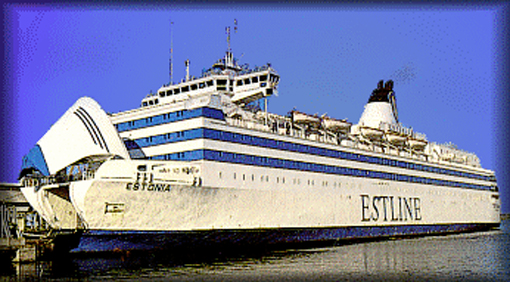
One of
the biggest post-war ship disasters occurred on the 28th of September in
1994. The passenger ship MS Estonia was on a cruise on
the Baltic Sea from Tallinn to Stockholm. They had departed from Tallinn
on the 27th at 7:00 p.m. local time and were scheduled to arrive at
Stockholm the morning thereafter at 9:30 a.m. local time. 989 people were on
board, of which 796 passengers and 193 were in the crew.
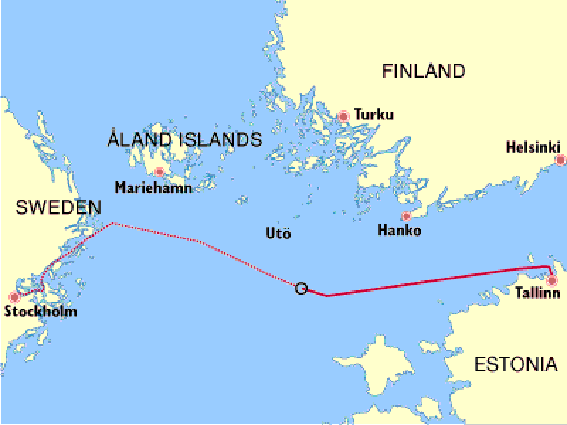
Estonia's route takes the form of a V
where she sank.
Its position was now about 35 km southeast of Finnish Utö. Surviving
passengers could witness that they experienced a thud in the ship at
0:55
a.m.
Around 1:20
a.m.
an alarm message was sent out over the
ship's speaker system. At 1:22
a.m. an emergency call was sent out
from the command line, "May Day", "May Day". All main generators had
stopped. The emergency generator started automatically. The ship was now
adrift. It took a starboard list. It increased rapidly. At around 1:30
a.m.
the ship's entire starboard side was under water. During the final
phase, the list was more than 90 degrees. The ship sank quickly with its
stern first. About 1:50 a.m. Estonia had disappeared from the radar screens
of surrounding ships. The disaster was a fact. 852 people had died. 137
were rescued.
During the following morning, media reported
about the disaster. The reason for the accident was that Estonia lost
its bow visor in the rough weather. The average wind was 12 - 20 m/s,
hard breeze. It was assumed that the ship's speed had been too high in
the rough sea. The strain on the bow visor became too big. The
visor separated from the bow and tilted over the stem.
The ramp was pulled fully open, allowing large amounts of water to enter
the car deck. Very rapidly the ship took on a heavy starboard list. She
was turned to port and slowed down. Estonia lost its stability,
capsized and sank.
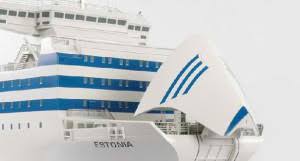
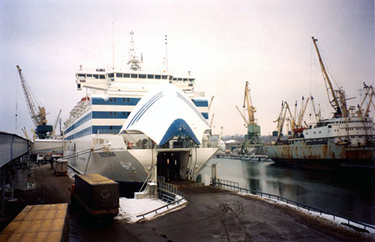
The bow visor in folded up position.
Estonia in port. The ramp is folded down.
Just below is a visible part of the ramp.
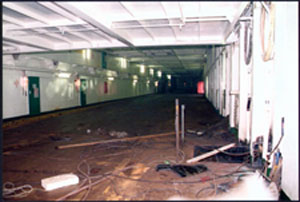
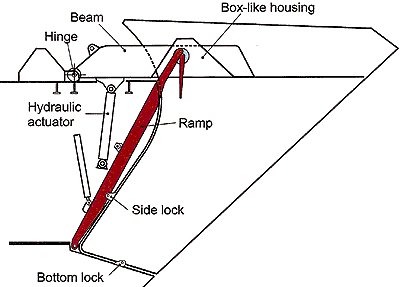
Interior from the car deck.
The bow visor and the
ramp in cross-section. The ramp
is sealing against the car deck in folded up position.
Investigating Commissions.
Two commissions have submitted their final reports:
A Swedish consortium called SSPA has submitted a
report. You can download it here:
SSPA Research Report No. 134, 2008.
(English)
The following summary is available for reading (page 9):
"The
Estonian-flagged ro-ro passenger ship MV Estonia departed from Tallinn
on 27th
of
September 1994 for a scheduled voyage to
Stockholm. At about 0115 hrs, Estonian time, the visor separated from
the bow, due to heavy wave loads, and tilted over the stem. The ramp was
pulled fully open, allowing large amounts of water to enter the car
deck. Very rapidly the ship took on a heavy starboard list. She was
turned to port and slowed down. The four main engines stopped and the
ship was now drifting. The list to starboard increased and water started
to enter the accommodation decks. The ship sank rapidly."
An investigating commission consisting of
representatives of the Estonian, Finnish and Swedish governments,
Joint Accident Investigation Commission, has
jointly submitted a report. You can read it on the Internet:
http://onse.fi/estonia/brindex.html
(English)
The report is very detailed and well written. As to the cause of the
accident, SSPA's opinion is shared as above.
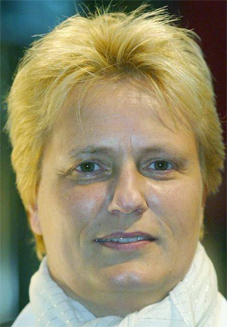
Jutta Rabe.
The German journalist Jutta Rabe is one of the private investigators who
sought the truth about Estonia's sinking. In August of 2000, she
undertook a diving expedition to the Baltic Sea. The wreck is located on
international waters, but the Swedish authorities have done everything
possible to prevent interested in investigating it. A law has been
established that prohibits Swedish citizens from going down to the
wreck. The site is monitored using an electronic buoy. Rabes team got a
visit from the Swedish Coast Guard when they arrived. The authority's
representative pronounces on threatening terms. He says that "This
is a crime in Sweden. You have to think if you come to Sweden on an
occation for something, you might risk to get in charge with the
Police.” Rabes team, however, fulfills its mission. She has
produced a video showing how the expedition was conducted. At 12:34 min
into the video the ultimate evidence that Estonia was sanked by an
explosive charge is shown. A hole is located at starboard bow. It is
about 2m long and about 0.6m wide. It is clearly below the waterline of
the vessel. This is the reason for the rapid progress of the sinking.
Here you can watch the video:
MS Estonia - Jutta Rabe - the
secret of how the ship got blown up
(German, English)
In the video Rabe
submits a theory, that completely disintegrates the statements made by
the SSPA
and the Joint Accident
Investigation Commission,
regarding the bow visor:
“They said that the water came into the car deck which made the ship
capsize, even turning her around onto her top and then the ship sunk
like a stone to the bottom of the Baltic Sea, where she lies today. But
this is against the law of physics, since there are three more decks
underneath the car deck filled with air. That's the reason why a ship is
swimming in the first place. When a ship capsizes and topples over, this
air stays locked inside and the ship keeps swimming on the surface for
hours, sometimes days, as it was in the case with "Jan Hewelius",
another shipping catastrophe. Only when the air slowly escapes this
trap, the ship will sink to the bottom of the sea. But in the case of
Estonia many witnesses, survivors, reported that the ship moved up with
her bow one last time before sinking to the bottom of the sea, where
until today, she is still lying in the same position. This means water
must have been coming into the ship from underneath, from a hole or some
kind of opening, through which the ship filled with water and at the
same time pressed the air up and out. Only that way it would have been
possible for the ship to sink to the bottom of the sea like a stone. So,
if we can assume that a damage in the hull of Estonia was the reason for
the quick sinking, the next question, of course, is: How did the hull,
which consists of one centimetre strong steel, get damaged? There are
very few possible explanations. An explosion is one, which should be
seriously considered."
The Blow Up.

Several explosive charges were placed in the ship's bow area. The charge
that tore up the hole and is shown in the video had been placed where
the red square appears. The divers also have filmed explosion charges
which were not detonated but still remained inside the bow area. Where
the text "Estline" appears, there were two car decks. There were three
decks below for engine rooms, fuel tanks, etc. The bulkheads between the
car decks and those underlying decks were dense. As the water gushed
through the blasthole it pressed the air out through the hole. The ship
then became unstable and canted. Above the car deck there were passenger
cabins, restaurants, cafes etc.
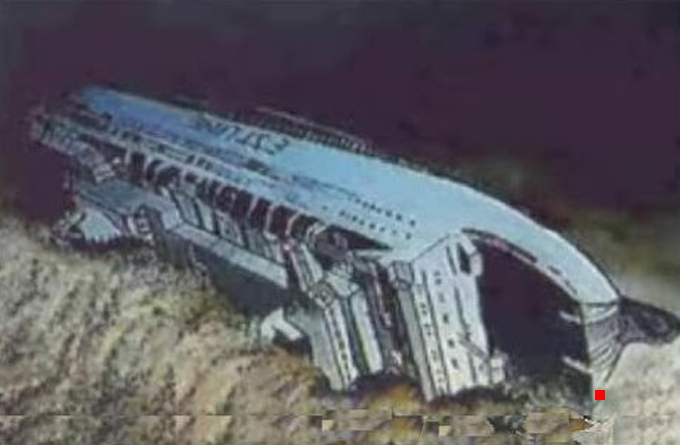
Estonia as she still in this day lies with the starboard side to
the seabed. The location of the
blasted hole is at the red square.

A diver measures the blasthole with a
measuring stick, about 2 m x 0.6 m. Note:
the blasted metal sheet is flared outwards.
During my military service at I 19, Boden, 1966 – 1967,
I was placed at an engineering unit. There I learned a lot about
blasting technique. With the knowledge I have in the field, I would like
to say that it requires expertise to perform a blast like this. My
suspicions fall on Nazi elements within the Swedish military.
The passengers.
Which one's were on Estonia on the departure from Tallinn? This is an
issue that has not yet been fully clarified. There are reasons to doubt
that it ever will be completely resolved. My working hypothesis in this
part has been that the Swedish Nazis are behind the sinking of Estonia.
In that case, it should mean that the victims were, at least to some
extent, those whom the Nazis wanted to see on the ship that fatal night.
About two weeks before the disaster, I was suggested by a person in
Stockholm to make a cruise with Estonia to Tallinn. It was with some
surprise that I received this proposal. I had previously read about the
murders of the trade union leaders Bertil Whinberg and
Ove Fredriksson in Tallinn, January
1991. Media pointed out that the city was a retreat for the Russian
mafia. I had no interest in visiting Tallin.
Tallink, the shipping company in charge of Estonia
failed to produce accurate passenger lists after the disaster. The
Estonian Ministry of Internal Affairs was then commissioned to make a
summary. Several attempts were made but they failed. One reason is
considered to be that the mafia each time managed to get names to the
list that had not been onboard the boat. Latent there was a risk of
insurance fraud with this uncertainty.
In the first place I have taken an interest in the Swedish passengers. I
have taken part of a passenger list compiled by the Swedish National
Police Office. It contains 989 names. From this list I have compiled a
list of those who were registered for census in
Sweden on the 28th of Septemer, 1994. This list contains a
total of 562 names. The predominant part is Swedes, but other
nationalities are due. In the remark column I have indicated those who
have been rescued. Others are fatalities. Street
addresses are listed without house number.

The list is produced in Excel format. It is possible to search for
specific names as well as
doing statistical runs on the population as a whole.
You can download the list here:
Estonia - passagerare mantalsskrivna i Sverige den 1994-09-28
Mapping in Google Earth
With the Google Earth free app, I show the passengers' geographical
location in Sweden. You can put placemarks in the program. These can be
imported into the program by any user. Placemarks have been posted
according to the address information in the list.
My assumption is that the Swedish Nazis "recruited" many people to the
fatal journey. When you look at the map images around the placemarks you
can get guidance. It is obvious that the people who selected the victims
have had access to overview maps. Google Eart was not available in 1994,
but other computerized map databases may have been used. As an example,
the map image of the Ola Söderlund placemark can be
shown. Söderlund was resident at Kartstigen,
Vilhelmina.
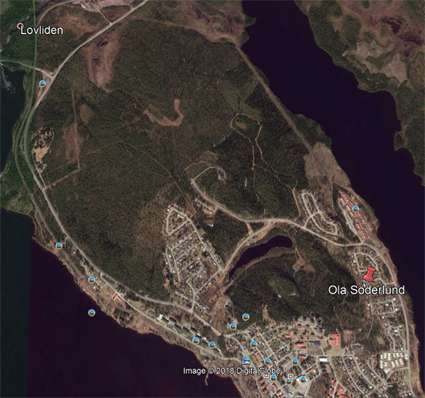
Map image for the Ola Söderlund placemark.
The program's menu allows you to click on a placemark. Then the current
location is displayed. In most cases, you can go down to the ground
level to review the surroundings.
Here you can download the placemarks:
Platser-Estonia.zip
(562 off)
NOTE! The files are compressed in zip format. Before you can use them,
you need to unpack them. This can be done using WinZip software:
http://www.winzip.com/win/se
Tip: If you have previously downloaded placemarks for
murder victims
(yellow) from this website, you can easily compare them to Estonia's
(red). If you want other colors, you can edit in Google Earth:
1. Right-click a placemark in the menu on the left.
2. Select Properties.
3. A dialog box appears.
4. Click the placemark icon in the upper right corner,
5. Select a placemark.
6. Click OK.
The crew.

Carita Barasinski
Estonia's crew consisted of the majority of Estonian citizens. Here I
let the Swedish representation consist of only one crew member. Her name
was Carita Barasinski (1965 - 1994). She was married to
Peter Barasinski. They worked with management and
training of newly employed staff. Peter was not in service at the
sinking. He died in cancer in 2006.
YouTube Video: Celine Dion - My Heart Will Go
On - Music Video Titanic Soundtrack
MS Estonia - facts
Departure from Tallinn: 1994-09-27 at 7:00
p.m.
local time.
Scheduled arrival to Stockholm: 1994-09-28 at 9:30
a.m. local time.
Average speed to keep the schedule: 16.5 knots (30.6 km / h).
Vessel: Length: 155.4m, Width: 24.2m.
The vessel was certified for 2000 passengers.
989 people were on board when departing from Tallinn, of which 796
passengers and 193 were in the crew.
The sinking started 1994-09-28 at 00:55
a.m.
Survivor passengers have testified that they felt a
thud in
the ship.
Position: about 35 km southeast of Finnish Utö.
The ship had sunk completely at 1.48
a.m. at
the depth of 85 m. Position: 59°23'N 21°42'E
The time of sinking was less than 1 hour.
Significant wave height: 4 - 4.4 m.
Average wind: 12 - 20 m / sec.
Air temperature: + 8° C to + 12° C.
Water temperature at the sea level: + 12° C to + 13° C.
852 fatalities , of which 501 Swedish citizens.
137 rescued.
In January 1993, the ship was sold to the
Swedish company Nordström & Thulin, partner of Estline, together with
the Estonian State's Estonian Shipping Company, and was
registered both by Estline and Cypriot Estline Marine Co. Ltd in Nicosia
due to claims from the lender, The European Bank for Reconstruction and
Developmen (EBRD). She now got the name MS Estonia and was entered on
the Tallinn-Stockholm route.
Military insanity at
Lake
Armasjärvi in
1940.
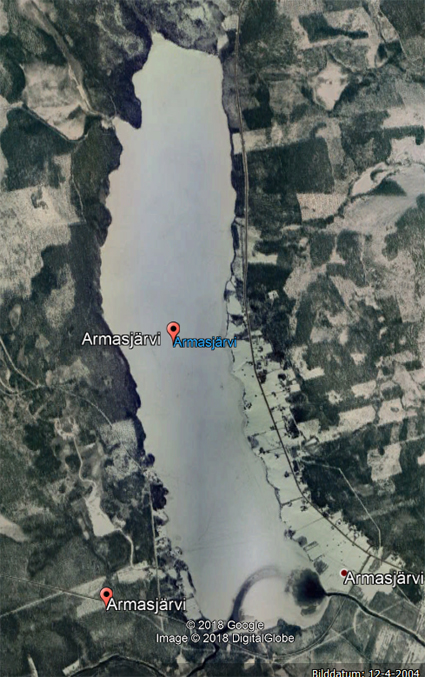
Map view of Armasjärvi (The
Lake Of Love).
Photo: Google Earth
Lake Armasjärvi and the small
community of the same name are located in Torneådalen, near the Finnish
border. It is about 5 km long and 1 km wide. Near the middle of the lake
there was a ferry in traffic in 1940. The
following is available for reading in Wikipedia:
"The Armasjärvi accident is one of
the hardest accidents that hit the Swedish defense in peacetime. The
accident occurred during the days of military preparedness in the hours
of the evening of October 24th, 1940, on Lake Armasjärvi in Torneådalen,
where a ferry sank and 46 men were killed. The accident happened when an
engineering company from Boden's engineering
regiment was to be crossed from the west to east side of the lake, where
their accommodations were located. Two platoons,
about 100 men, were ordered to step on the ferry, even though the
ferryman protested and claimed that the ferry was only dimensioned for
about the half. The ferry capsized halfway on the 1 km wide lake. The
water was ice cold, the soldiers were heavily equipped and it was also a
hard wind. 46 men were killed, 44 of whom were soldiers and two
civilians."
This "accident" occurred about 8 months after the
blow up of Norrskensflamman. The platoons that were affected came from
the same regiments, Ing 3, as the responsible Second Lieutenants
at Norrskensflamman.
The responsible commander at Armasjärvi was Ivan Pellijeff,
a Second Lieutenant. He came to be charged with "unrest in service" but
was acquitted.
Some victims
in
comparison with
Ernest Louis of Hesse:
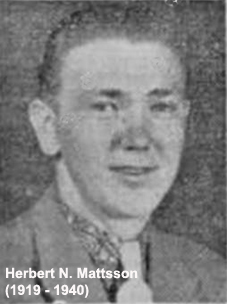

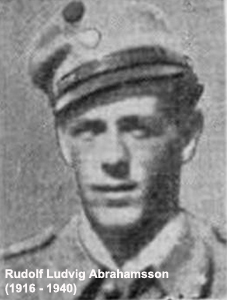
Ernest Louis of Hesse
(1868 - 1937)
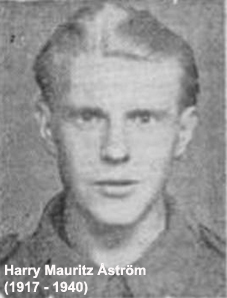

Ernest Louis of Hesse
(1868 - 1937)
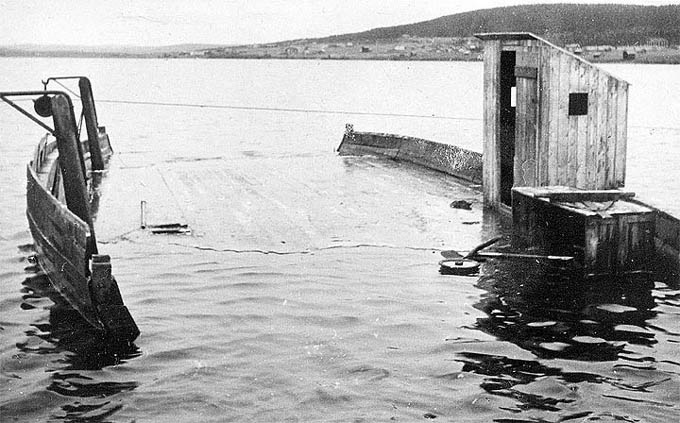
The capsized ferry.
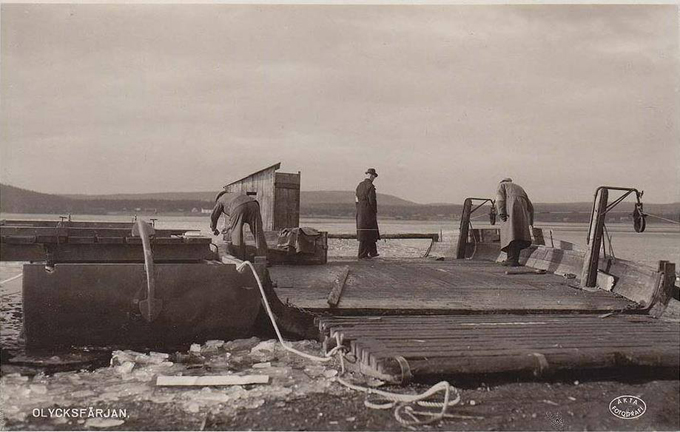
The ferry is inspected.
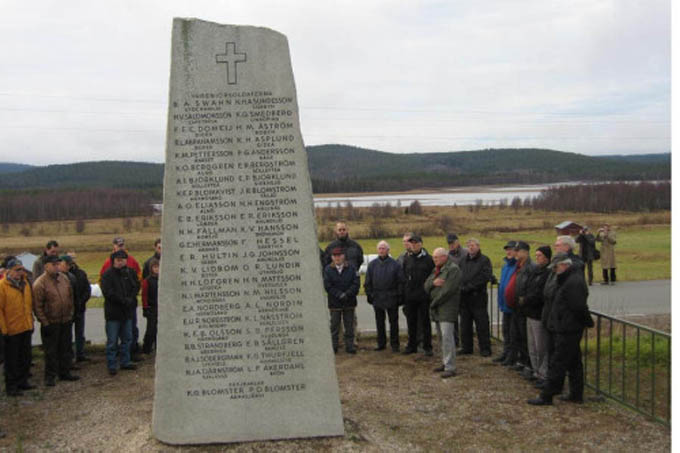
Memorial at Lake Armasjärvi.